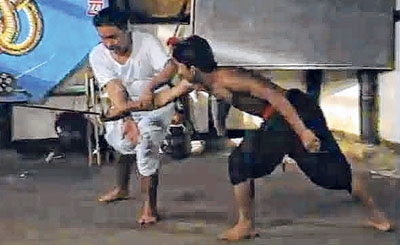Preserving Thang-ta traditions
|

Khilton Nongmaithem in collaboration with Dainis Jirgensons and Loyd Gore
"Tradition is not the worship of ashes, but the preservation of fire."-Gustav Mahler
The present-day teaching of Thang-Ta - and many other traditional Manipuri art forms - lack features that were essential elements of the traditional teaching method. Classes are taught in a standardized way, often within educational institutions, with time constraints and a rigid, set curriculum. Certificates are awarded to signify advancement from one level to the next. The student-teacher relationship is essentially non-existent.
I think the essence of the art is lost in the process.
During the time I studied under OJa Devabrata Sinam, I witnessed the transition from the traditional way to the modern practice. In the traditional method the student would spend as much time as possible with the teacher, sometimes spending the entire day at the teacher's house. The teacher would give students individualized lessons based on the student's ability and dedication. Some students would advance slowly, requiring more time to learn the basics. One or two students who showed great promise could live at the teacher's house, participating in the daily life of the teacher as a member of the family.
Live-in students were expected to clean the house, help with chores, gardening, etc. and attend social activities. In this way the student learned proper behavior, followed the daily regimen of the teacher, and when the opportunity arose, received deeper instruction in Thang-Ta.
For example, it was customary for the disciple to wash the teacher's feet in the evening before retiring. Depending on the mood of the teacher, he might give advanced instruction that is passed person-to-person - "only to one ear" - and not to be shared with others.
Living at the teacher's house did not guarantee any special instruction. The student still needed to ask the right questions, show some creativity, and be ready to learn at any time. The instruction, when it occurred, was spontaneous, triggered by circumstance. During gardening, for example, a casual conversation could trigger a memory that inspires the lesson on handling a dangerous situation. The teacher asks how the student would handle it, encouraging creative thinking. It was not necessary for the student to be correct necessarily. In fact, being always correct could discourage instruction.
Through this kind of instruction, following the teacher's actions, a kind of gracefulness develops, not just in Thang-ta but in everyday activities. Following the teacher's routine from sunrise to retirement for the night, he can observe how he does chingkeirol, for example. When travelling with the teacher the student assumes more responsibilities, taking care of things like making the teacher's bed, etc.
My teacher was the first to institute a standard 5-year curriculum of instruction because he realized the times were changing and the art was in danger of being lost. But he also retained elements of the traditional teaching practice.
For talented and interested students individual training was still available, either during or outside the class.
In my teacher's curriculum there was a monthly lesson on what you could call "civic studies": etiquette, behavior, customs, rituals, history, battle ethics, mythology, basic healing, etc.(in addition to what the elders taught in class). This seems to be missing from the current instruction.
Most important is the development of the four qualities traditionally chanted by the presenter at the introduction of the spear form: swiftness, gentleness, firmness, fierceness (Chatle Nungsitkumba, phame nung-gumba, pamba keirel phangamba...).
Nowadays Thang-ta is being taught in schools and universities throughout the nation, but it is only the outer shell of the art. We need to make sure the essence is not being lost.
Dedicated to Lokendra Arambam, PhD

